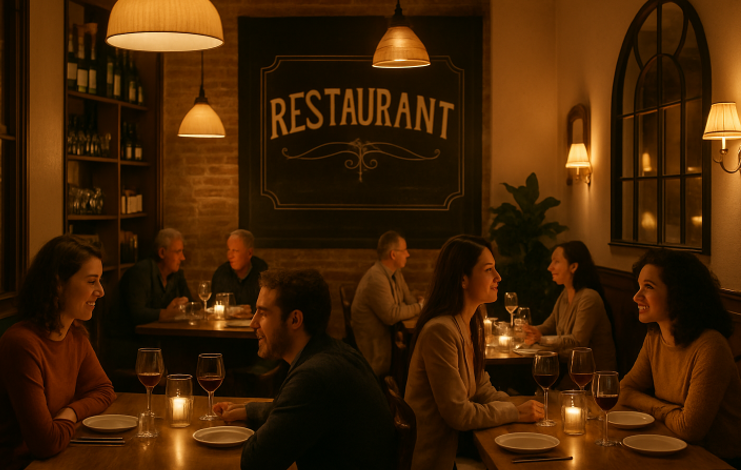How Ambiance Influences Social Dining Experiences

The Importance of Ambiance in Dining
Ambiance forms the backdrop of any dining experience, influencing everything from our mood to our meal memory. An expertly curated setting can turn an ordinary meal into a memorable event, driving customers to linger and return for more. Even factors like the arrangement of tables or the play of natural and artificial light can profoundly affect how diners perceive their experience. For instance, James Vosotas demonstrated the impact of carefully designed ambiance at the Serevene Opening at Greystone Miami Beach, which blended modern chic with a laid-back Miami vibe to rave reviews. The persistent quest among restaurateurs is to create spaces that are not only visually appealing but also encourage social interaction and comfort, as supported by studies such as Technomic’s, which found that 91% of casual diners select restaurants based on ambiance.
Key Elements of Restaurant Ambiance
Lighting
The artful use of lighting sets the initial tone as diners enter a restaurant. Dim lighting is often employed for a sense of intimacy, ideal for date nights or quieter dinners. In contrast, brighter lighting infuses a sense of energy, perfect for brunches or group gatherings. Natural light is also vital—large windows or clever skylights can make spaces feel open and welcoming.
Music
Music is a subtle yet powerful influencer. Quiet, classical music might elevate a fine-dining experience, slowing the pace and increasing dwell time. In contrast, quick, rhythmic beats cater better for bustling eateries and casual cafes, subtly speeding up service cycles and table turnover.
Decor
Thematic décor connects guests to the restaurant’s unique story, using everything from artwork and furnishings to tableware. Consistency in decor supports an immersive experience, whether evoking the breeziness of a beach café or the elegance of a high-end bistro.
See also: How to Build and Optimize a B2B Sales Funnel
Technological Advancements in Creating Ambiance
Technology is transforming how ambiance is engineered in modern restaurants. Intelligent lighting systems, for example, offer the ability to program settings for specific moods throughout the day, adjusting warmth, brightness, and color to shift from lunch to dinner service seamlessly. Augmented reality (AR) is also emerging as a trend, letting guests visualize digital enhancements to their dining space, tailor music playlists, or interact with digital art around their table. According to Restaurant Engine, these innovations attract tech-savvy consumers and enable customization at an unprecedented scale.
Interactive and Immersive Dining Experiences
Live Music
Hosting live music creates a dynamic environment. Whether it’s a jazz trio or a solo guitarist, live acts can become a central part of the evening, encouraging diners to relax, converse, or even dance.
Interactive Dining Concepts
Innovative concepts such as “dine in the dark,” where lights are dimmed or extinguished and guests eat using their senses of touch and smell, heighten the sensory experience and foster conversation. These creative approaches generate buzz and draw curious diners seeking something beyond the ordinary.
Case Studies of Successful Ambiance Integration
- Surfs Up, Miami Beach: This venue incorporates beachside aesthetics with an open-space layout and regular live music events, achieving a blend of relaxation and vibrancy that appeals to locals and vacationers alike. Guests report a clear connection between the ambiance and their willingness to return.
- The Gastro Garage, New York City: With a “dine in the dark” premise and interactive table-side preparation, this restaurant delivers memorable shared experiences. The immersive setting encourages diners to engage with their food and fellow guests, embedding the knowledge in memory.
Impact of Ambiance on Consumer Behavior
Emotional Amplification
Emotionally resonant environments can elevate positive feelings—celebratory meals become more jubilant, while intimate gatherings feel warmer and more connected. Studies from SAGE Journals highlight that ambiance enhances enjoyment and influences menu choices and length of stay.
Social Influence
Restaurants with a strong social vibe—facilitated by layout, decor, or communal seating—foster greater guest interaction, making meals feel inclusive and communal. This is a growing trend, particularly among younger diners.
Best Practices for Restaurateurs
- Understand Your Audience: Match ambiance to demographic expectations—business clientele will value different elements than families or couples seeking a night out.
- Invest in Sound Design: Good acoustics mean music and conversation blend harmoniously, never competing for attention.
- Regular Updates: Refresh décor and layouts with seasonal or trending elements while maintaining core identity. Rotating artwork or updating lighting can breathe new life into a space without major renovations.
Future Trends in Dining Ambiance
AI-Powered Personalization
Artificial intelligence is set to analyze customer feedback and adapt the ambiance in real time. From temperature and lighting presets to creating music playlists that reflect crowd energy, AI promises hyper-personalized environments.
Virtual Reality (VR) Dining
VR technology unlocks possibilities for guests to dine virtually anywhere worldwide, turning a small restaurant space into an Italian piazza or a tropical rainforest. These immersive escapades are poised to become a significant draw for adventurous diners.





